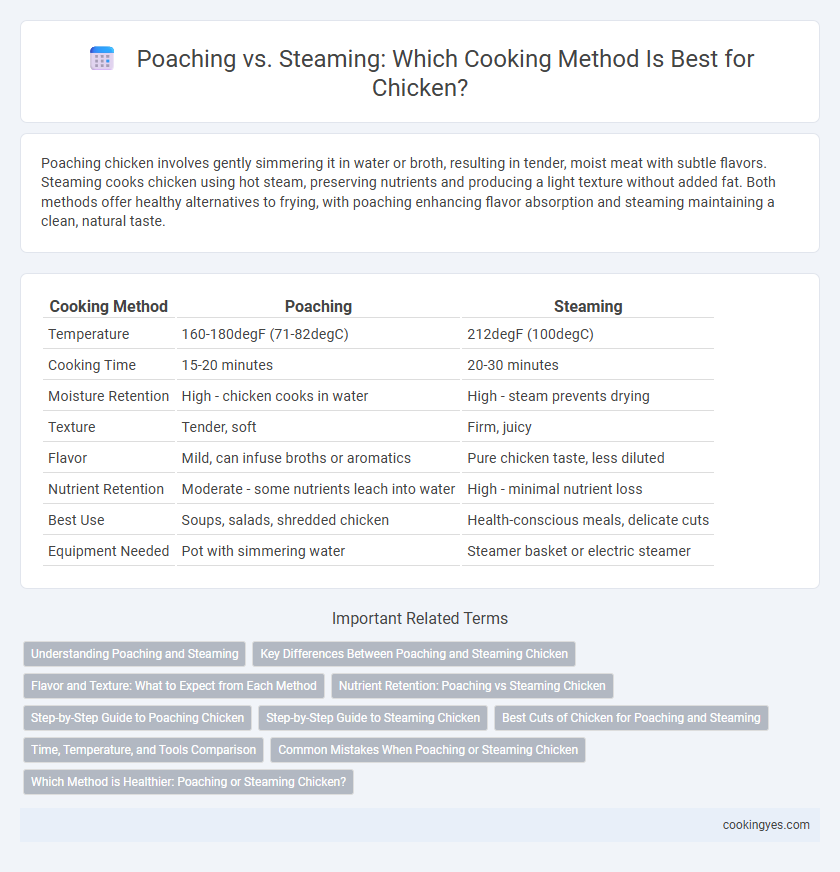Poaching chicken involves gently simmering it in water or broth, resulting in tender, moist meat with subtle flavors. Steaming cooks chicken using hot steam, preserving nutrients and producing a light texture without added fat. Both methods offer healthy alternatives to frying, with poaching enhancing flavor absorption and steaming maintaining a clean, natural taste.
Table of Comparison
| Cooking Method | Poaching | Steaming |
|---|---|---|
| Temperature | 160-180degF (71-82degC) | 212degF (100degC) |
| Cooking Time | 15-20 minutes | 20-30 minutes |
| Moisture Retention | High - chicken cooks in water | High - steam prevents drying |
| Texture | Tender, soft | Firm, juicy |
| Flavor | Mild, can infuse broths or aromatics | Pure chicken taste, less diluted |
| Nutrient Retention | Moderate - some nutrients leach into water | High - minimal nutrient loss |
| Best Use | Soups, salads, shredded chicken | Health-conscious meals, delicate cuts |
| Equipment Needed | Pot with simmering water | Steamer basket or electric steamer |
Understanding Poaching and Steaming
Poaching and steaming are gentle cooking methods ideal for preserving chicken's tenderness and moisture. Poaching involves submerging chicken in simmering liquid at temperatures between 160degF and 180degF, allowing flavors from broths or herbs to infuse the meat. Steaming cooks chicken using moist heat from boiling water beneath a perforated lid, maintaining nutrient retention while preventing direct contact with water.
Key Differences Between Poaching and Steaming Chicken
Poaching chicken involves cooking it gently in simmering water or broth, allowing the meat to absorb moisture and maintain tenderness, while steaming cooks chicken by exposing it to steam heat, preserving its natural flavor and nutrients without direct contact with water. Poaching often results in a more delicate texture with subtle seasoning infusion, whereas steaming provides a firmer texture and retains more vitamins such as B-complex and minerals due to minimal nutrient loss. Both methods are low-fat cooking techniques ideal for lean cuts like chicken breast but differ in moisture retention and flavor intensity.
Flavor and Texture: What to Expect from Each Method
Poaching chicken results in a tender, moist texture with a subtle, delicate flavor that allows natural chicken taste to shine without added fats. Steaming preserves juiciness while maintaining a firmer texture and provides a clean, pure chicken flavor, often enhanced by aromatic herbs or spices in the steaming liquid. Both methods retain nutritional value but differ in mouthfeel--poaching yields softer meat, whereas steaming offers a slightly more structured bite.
Nutrient Retention: Poaching vs Steaming Chicken
Poaching chicken involves gently simmering it in water or broth, which helps retain water-soluble vitamins like B-complex and minerals without adding fat. Steaming chicken cooks it by surrounding with hot steam, preserving nutrients such as vitamin C and retaining protein integrity due to the absence of direct water contact. Both methods minimize nutrient loss compared to boiling or frying, but steaming generally offers superior retention of vitamins sensitive to water exposure.
Step-by-Step Guide to Poaching Chicken
Poaching chicken involves gently simmering the poultry in water or broth at a low temperature, typically between 160degF and 180degF, to retain moisture and enhance tenderness. Begin by placing the chicken breasts in a single layer in a saucepan, then cover with cold liquid, adding aromatics like garlic, bay leaves, and peppercorns for flavor. Heat slowly until the liquid reaches a gentle simmer, cover the pan, and cook for 15-20 minutes until the chicken is fully cooked but still juicy.
Step-by-Step Guide to Steaming Chicken
Steaming chicken preserves moisture and nutrients by cooking it gently with hot steam, resulting in tender and juicy meat. To steam chicken, place seasoned chicken pieces in a single layer on a heatproof plate or steaming basket above simmering water, cover with a lid, and steam for 15-20 minutes until the internal temperature reaches 165degF (74degC). This method prevents overcooking and enhances the natural flavor, making it a healthy alternative to poaching, which involves cooking chicken directly in simmering water.
Best Cuts of Chicken for Poaching and Steaming
Poaching is ideal for delicate chicken cuts like breasts and tenderloins, preserving moisture and tenderness through gentle cooking in flavorful liquid. Steaming works well with slightly thicker cuts such as chicken thighs and drumsticks, allowing even heat to penetrate while retaining juiciness and nutrients. Both methods enhance lean cuts but steaming better maintains texture in pieces with higher fat content.
Time, Temperature, and Tools Comparison
Poaching chicken involves gently cooking it in simmering liquid at temperatures between 160degF to 180degF for 15 to 20 minutes using a pot or shallow pan, ensuring tender, moist meat while retaining flavors without added fat. Steaming chicken requires a consistent temperature of 212degF, typically taking 20 to 30 minutes depending on thickness, with tools like a steamer basket or electric steamer that preserve nutrients and produce a delicate texture. Both methods offer healthy alternatives, but poaching's lower temperature often allows more precise control over doneness, whereas steaming provides even heat distribution across the chicken pieces.
Common Mistakes When Poaching or Steaming Chicken
Overcooking is a common mistake when poaching chicken, leading to dry and tough meat due to excessive heat exposure in the poaching liquid. Steaming errors often include insufficient steaming time or uneven heat distribution, causing undercooked or rubbery chicken texture. Maintaining precise temperature control and monitoring cooking duration are essential to retain moisture and achieve tender, juicy chicken in both poaching and steaming methods.
Which Method is Healthier: Poaching or Steaming Chicken?
Poaching chicken involves cooking it gently in simmering liquid, which helps retain moisture and nutrients without added fats. Steaming chicken uses hot vapor to cook the meat, preserving vitamins and keeping the texture tender while avoiding any oil. Both methods are healthy, but steaming slightly edges out poaching by minimizing nutrient loss and preventing the chicken from absorbing extra water.
Poaching vs Steaming for chicken cooking methods Infographic

 cookingyes.com
cookingyes.com